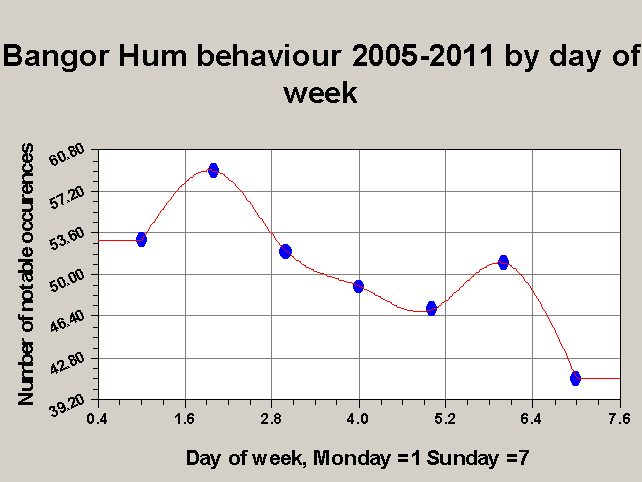
Is the Hum due to an anthropogenic source? A five year day by day study.
By Dr Chris Barnes, Bangor Scientific Consultants
email ; scienceconsultants@yahoo.co.uk
ABSTRACT
Debate is still rife on Internet forums concerning the cause of the Hum. Even Wikipedia states it could be of natural origin. However, the evidence presented here shows the Hum at least in Bangor to have a Tuesday maximum and a Sunday minimum. Such behaviour is more characteristic of an anthropogenic source. Further analysis shows a strong positive correlation with the load on the UK power grid and a positive cubic relationship with the mean time adjusted loads on the US and UK power grids. Power grid loads are in themselves indicators of levels of anthropogenic activity and their other consequences such as airborne noise and seismic vibration.
Introduction
The Hum is an enigmatic (magneto) (gravito) acoustic phenomenon first reported in Britain in the 1970’s and later in the USA in the early 1990’s1. Hearers of the Hum usually report hearing a noise like a distant idling engine and usually although not exclusively in the night when it is extremely quiet. Some also report the noise as being difficult to screen out even using ear plugs and therefore capable of causing sleep deprivation, general annoyance and anxiety. There would appear to more outbreaks of the Hum being reported throughout the World in recent times so its emergence would appear in some way to map infrastructure development.
The present author, his wife, his sister-in law and occasionally his son are all hearers of the Hum. Thus all the studies made by the present author have a subjective element but have not required anecdotal input from unknown or unreliable third parties. The author loosely describes the Hum in the North Wales region as the Bangor Hum. It would seem it has all the characteristics of hums reported anecdotally around the World. It would not then seem too unreasonable to propose extension of hypotheses concerning the Bangor Hum to those more generally.
There is huge and often heated debate on Hum forums concerning the cause(s) of the Hum. Some cases of the Hum have been solved. Kokomo, for example, comes to light as an example thought to involve anthropogenic acoustic and infrasonic noise2. Following this lead, some groups in the USA are convinced that the Hum is due to high pressure gas mains3. Some groups in both the USA and UK believe the Hum to have an electro-acoustic connection and, perhaps, be related in some way to Tetra masts4. However, since the Hum pre-dates these and the demodulated waveforms do not correspond with what is heard it may be fairly safe to dismiss this as the direct cause. Occupational exposure to radio frequencies, perhaps including Tetra, can however desensitise hearing above 4 KHz and maybe the body ramps up Low Frequency Audition to compensate, the present author hopes to report more on this in the near future. This would also explain why 40 MHz PLT systems are presently being blamed for increased in the Hum in the US on Hum Forums right now!
After very extensive studies the present author has come to conclusion that at least for the Hum in Bangor and possibly World Wide the most likely main culprit in the Hum is the interaction with the World’s electricity grids and the Earth’s space weather environment. That is not to say however that the space weather environment would not or could not alter the propagation characteristics of virtually any airborne or ground borne noise, anthropogenic or otherwise, due to magnetosphere-atmosphere-lithosphere interactions. Since the Hum can be dependent on room or building resonance5 and is a very subjective phenomenon it must not be forgotten that more than one driver could potentially produce the same or very similar psycho acoustic sensations.
Hypothesis
If the Hum were caused by a purely natural phenomena there ought to be the same statistical chance of experiencing it irrespective of day of the week. Alternatively if the Hum were of anthropogenic origin or a natural phenomenon modulated or mediated by an anthropogenic source then perhaps its behaviour on some days of the week would be different.
Experimental Results and Discussion
The experiment is very simple, Retrospective data for the subjective Hum intensity in Bangor has been gathered over the last five years by the present author. Only those data from still days (no significant wind) were used as it has previously been shown that winds of certain speeds can blow out the coherence of the Hum. The subjective Hum levels were recorded as four discrete values on a scale of 0-10. Where 10 = intolerable levels even with wax ear plugs; 7 = Hum bad enough to need ear plugs. 4= Hum which could be lost simply by burying one’s heads in a pillow and finally where 0= no Hum at all. The numbers of days of significant Hum events, greater than scale 7 were recorded against days of the week.

The results are presented graphically in Figure 1 above.
During the five year period the average number of significant events corresponding with any one day of the week is 50.29 with a standard deviation of 5.5. It can be seen that at least the result for significant Hum on 59 Tuesdays and only 41 Sundays during the period are well outside the expectation defined by the standard deviation and thus believed to be statistically significant.
Dawes6 has stated previously that the Hum maximises at weekends when the load on the UK electricity grid is minimal. This present result, at least for the Hum in Bangor does not support Dawes’ hypothesis. The result is however strongly suggestive that the Hum is due to anthropogenic cause or causes or equally valid and alternatively that it could be due to a natural source being modulated or mediated by anthropogenic phenomena. In this respect a very similar behaviour for the anthropogenic effect on rainfall levels has recently been observed, with Tuesday being noted as the wettest day of the week and Saturday is becoming wetter7. The author has searched the Internet extensively for time series charts in relation to anthropogenic activity such as power generation and consumption, road traffic usage, air passenger miles and the like but very little is available. All that has been found to date is a plot of electricity demand for Texas during a week in August 2011, a plot for average electricity demand in the rural US and a plot for the last week's electricity demand in the UK.
The UK electricity demand plot for a week in November 2011 is shown below courtesy of National grid
Attempts have been made to correlate the data on a day by day basis with Bangor Hum instances
F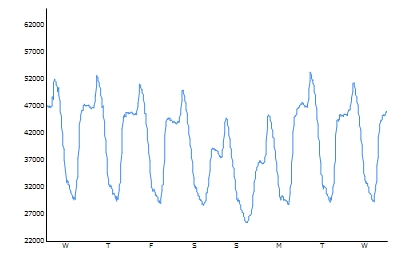
igure
2: 7days UK demand from 23 Nov to 30th Nov 2011,
Courtesy of National Grid
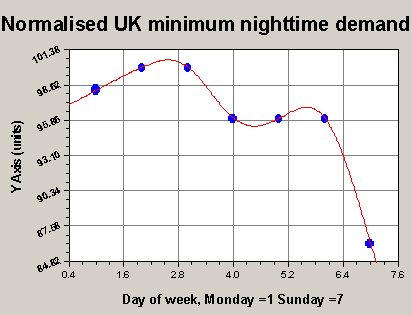
Figure 3: those data of figure 2 re-plotted in Bangor Hum format
Looking at figure 3, dual peaks on a Tuesday and Saturday are evident exactly as for average behaviour of the Bangor Hum over the last five years; moreover a distinct minimum is present on a Sunday again fully consistent with the behaviour of the Bangor Hum. From a comparison of figures 1 and 3 a reasonable correlation is expected. Figure 4 below tests that correlation by linear regression.
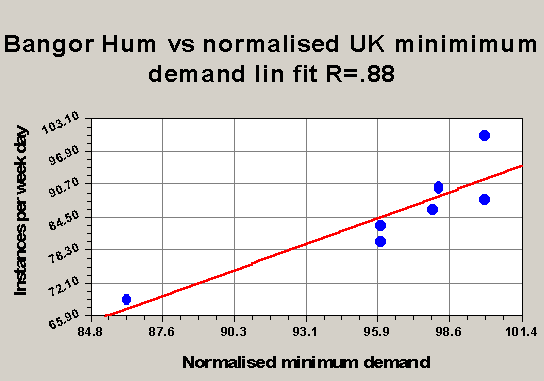
Figure 4 : Linear regression Bangor Hum instances versus demand matched per weekday
Given the very subjective nature of the Hum, the regression factor of 0.88 is very convincing.
It is in tremendous support for the case that the Hum is either of direct anthropogenic origin or alternatively is a natural process modulated or mediated by an anthropogenic signal. Furthermore there is strong support that the Hum is related to the power generation and/or distribution industry. It must not be forgotten however that electricity consumption is a general indicator of anthropogenic activity in general including waste heat generation, vehicular movement and general noise and vibration. Inclusion of time shifted data for electricity demand in the USA diminishes the regression factor to the order of 0.8 but given the very limited data sets available this is hardly surprising. Attempts to correlate the Bangor Hum with purely US electricity demand fail with a regression factor in the region of 0.44.
Clearly then either the Hum is as previously postulated the result of the interactions of World electricity grids in space or the result of the UK grid alone. It should be remembered that interactions involving the magnetosphere are likely to be non-linear and only linear correlations have been considered above. If we allow for non –linear interactions and take all available data for US rural as well as urban situations and pair this with data from the UK grid the following plot, figure 5 is obtained
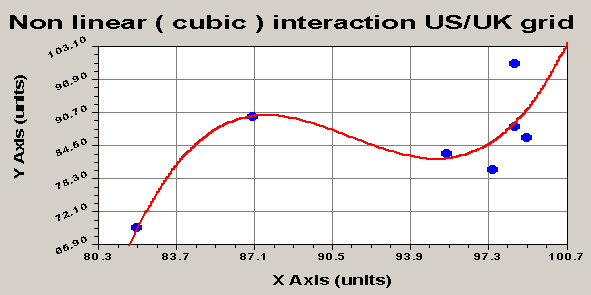
Figure 5
Although the regression factor is only 0.81, it is well within the limits of experimental error and an excellent data fit to the various weekday Hum instances is obtained.
Returning to the argument of Dawes that the Hum maximises when the load on the electricity grid is minimal, since the Hum is minimal on Sundays there is an obvious flaw here.
So for the Hum weekday instances of the Hum are seen generally to maximise when the load is minimum but their frequency is seen to increase as the minimal load increases. Thus there is a sort of truth in Dawes’ logic which may lie in one of two coincidences or in both. Either the Hum maximises at night because something is used in relation to electricity supply at night i.e. pumped storage generation or because some natural process involving the earth lithosphere, atmosphere and ionosphere is more easily modulated or mediated by power grids at night or both! This opens up another possibility mentioned by Dawes but formerly dismissed by the present author as an absolute pre-requisite for Hum perception. This is that of gravito-type interactions involving the Hum. In his 1989 paper EH Brandt8 discusses all the known mechanisms of levitation in Physics. Two cases in particular are relevant to the Hum. Firstly, a conductor in a radio frequency field will levitate. Secondly, charged particles in alternating electric or magnetic fields will levitate. Both cases exist for the power line –ionosphere interaction. Presumably if the alternating electric field is pulsed as with power line harmonic emission then the height of the ionosphere will pulsate in sympathy effectively altering the gravitational pull on the atmosphere albeit a minutia. The same minutia will generate a sound pressure wave, both manifestations of the Hum. More detail on how a pulsed ELF wave might affect gravity is given by Fran D'Aquino9. A reader will require very advanced mathematical skills to follow this document and a word of caution is that not all classical Physicists accept his arguments nevertheless this is fascinating reading and starkly profound if proven to be correct! It also adds considerable weight to the various Russian theoretical papers on lithosphere- atmosphere- ionosphere coupling10, 11 .
Coming nearer to earth it is conceivable that so called PLT (power line broadband systems) which radiate their own radio frequency fields from and to conductors in power lines may be yet another source of pulsed levitation i.e. sound wave production. Similarly this could happen for power lines in the path of other strong pulsed radio waves e.g. Tetra.
Previous works of the present author suggest all these cases as distinct possibilities and he has specifically referred to two channels of conduction for the Hum and a sort of coherence between them which simply highlights the incredible complexity of the enigma known as the Hum.
References
D.Deming, The Hum an anomalous sound around the world http://www.scientificexploration.org/journal/jse_18_4_deming.pdf
The Kokomo Hum Report can now only be found at http://docs.google.com/viewer?a=v&q=cache:XkHuF3EPNrUJ:www.johndawes.pwp.blueyonder.co.uk/kokomo1.pdf+kokomo+hum+report&hl=en&gl=uk&pid=bl&srcid=ADGEESgyMMgdixH7BbuC2s2OZQpxXM6GArAJuM9EFwOA2Rw9fQ4B1Gzky-NhpJV-HhrFSgyZ0WbaoQ9GjalkdDwyYzK40u9vbWAltqUUM--0Cz5kdMcABT3PBcEa6hWNqStozio4dl1P&sig=AHIEtbSfehviMKaoV-Bx_LVVG2YiEjJTTQ
Steve Kohlasse, personal communication
Sussex Tetra Survey ,July 2006, http://www.tetrawatch.net/papers/mast_survey_06.pdf
‘Some short comments on a particular case of the Hum and room resonance’ By Dr C. Barnes, February 2011, http://www.btinternet.com/~gmbarnes/HUMROOM.htm
http://www.telegraph.co.uk/topics/weather/6413555/Tuesday-is-the-rainiest-day.html.
E.H.Brandt, Levitation in Physics, Science 243( 4889),pp349-355, 1989.
http://hal.archives-ouvertes.fr/docs/00/61/05/30/PDF/ELF_Earthquakes.pdf
V.A. Liperovsky et al, http://www.agnld.uni-potsdam.de/~shw/Paper/NLD-Preprints/67_2007-Meister/rev1.pdf
O. Molchanov et al, http://hal.archives-ouvertes.fr/docs/00/29/92/24/PDF/nhess-4-757-2004.pdf